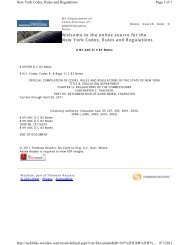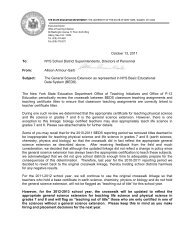ESL Learning Standards - Higher Ed - New York State Education ...
ESL Learning Standards - Higher Ed - New York State Education ...
ESL Learning Standards - Higher Ed - New York State Education ...
You also want an ePaper? Increase the reach of your titles
YUMPU automatically turns print PDFs into web optimized ePapers that Google loves.
Students learning English as a second language will use English to interact with others in social and<br />
classroom situations. They will develop and use skills and strategies appropriate to their level of<br />
English proficiency to communicate effectively with regard to audience, purpose, and setting.<br />
Performance Indicators: See page 24<br />
Advanced<br />
Students complete Intermediate task, and take notes during<br />
the role-plays. In groups, they prepare a question-andanswer<br />
orientation booklet to be given to new foreign<br />
exchange students or newly arrived immigrant students.<br />
Performance indicators: 1, 3, 4, 6, 9<br />
English Proficiency Level<br />
Transitional<br />
Students read articles about high schools in various countries<br />
and brainstorm aspects of American high schools that<br />
exchange students from these countries might find confusing.<br />
Students are each assigned a country, and they write a<br />
friendly welcome letter to a hypothetical exchange student<br />
from that country, describing these aspects of their high<br />
school and making suggestions on how to adjust to the<br />
new environment. Students share their letters with the<br />
whole group, and reflect on written communication strategies<br />
they used to help the exchange student feel more at<br />
ease.<br />
Performance indicators: 1, 3, 5<br />
After a discussion about favorite sports, the teacher provides<br />
students with several scenarios in which the sport<br />
will be removed from the interscholastic sports program<br />
(on account of budget issues, too few players, problems<br />
with scheduling practices, etc.). In pairs, students prepare<br />
a statement to be read to the board of education persuading<br />
them not to eliminate the sport.<br />
Performance indicators: 1, 2, 4, 5, 9, 12<br />
Using teacher-provided resources, students research the<br />
requirements of various career paths and take notes. The<br />
teacher organizes a mock job fair. Half the class role-plays<br />
recruiters from various careers, and the other half role-plays<br />
job seekers. Recruiters must prepare a list of interview<br />
questions suitable for their “vacancy.” Students circulate<br />
through the fair, interviewing for various jobs. Then students<br />
switch roles, and circulate through the fair again.<br />
Class debriefs on types of interview questions that were<br />
challenging, simple, informative, etc.<br />
Performance indicators: 3, 4, 5, 6, 7, 8, 9, 12<br />
The teacher provides groups of students with different<br />
emergency scenarios. Each group member is provided<br />
with descriptions of various roles involved in the emergency<br />
(i.e., victim, firefighter, neighbor, ambulance driver, etc.).<br />
Students improvise the emergency scene while staying in<br />
character. Afterwards, students analyze their speaking and<br />
discuss how factors such as tone, vocabulary, and intonation<br />
can affect communication.<br />
Performance indicators: 1, 3, 6, 9, 11, 12<br />
Using a computer program (word processing, desktop publishing),<br />
students design and write a brochure describing<br />
the schools’ interscholastic sports program for incoming<br />
freshmen. The brochure should include details such as<br />
academic standards for student athletes, criteria for lettering<br />
in varsity sports, demands of different sports, schedules for<br />
tryouts and practices, etc.<br />
Performance indicators: 2, 9, 12<br />
Using teacher-provided resources, students research the<br />
requirements of various career paths of interest to them,<br />
and choose one they are interested in pursuing. They<br />
develop a written career plan which includes: how they<br />
will meet the educational requirements (degree, certificate,<br />
or other training); how they will pay for the training/education<br />
through loans, grants, gifts, etc.; and where and how<br />
they will search for a job once their training is completed.<br />
Students present their plans to the class.<br />
Performance indicators: 3, 5, 9<br />
Students read newspaper reports of various emergencies<br />
such as fires, accidents, weather disasters, etc. After class<br />
brainstorms other emergency scenarios, students pretend<br />
that they are a newspaper reporter at the scene of an emergency,<br />
and they write a newspaper article about the situation,<br />
which includes dialogue from interviews with victims,<br />
911 calls, etc. In small groups, students read and respond<br />
to each other’s articles.<br />
Performance indicators: 1, 3, 6, 9, 11, 12<br />
Continued on next page<br />
<strong>ESL</strong><br />
4<br />
Comm<br />
CLASSROOM<br />
TASKS<br />
Sample Classroom Tasks 101
















